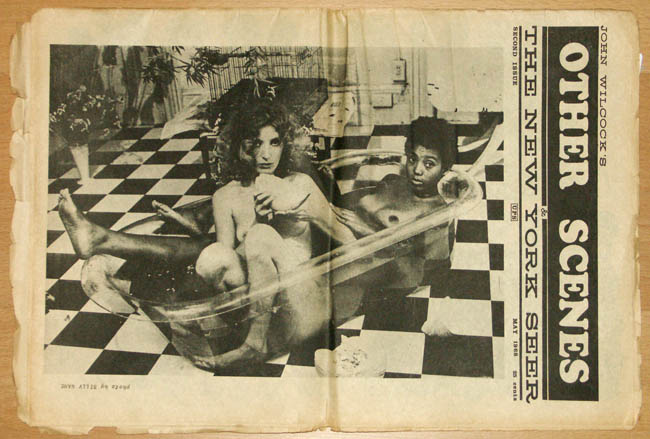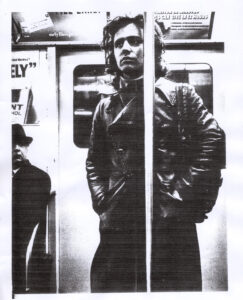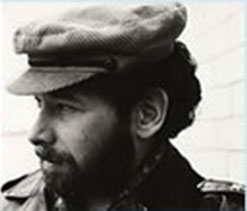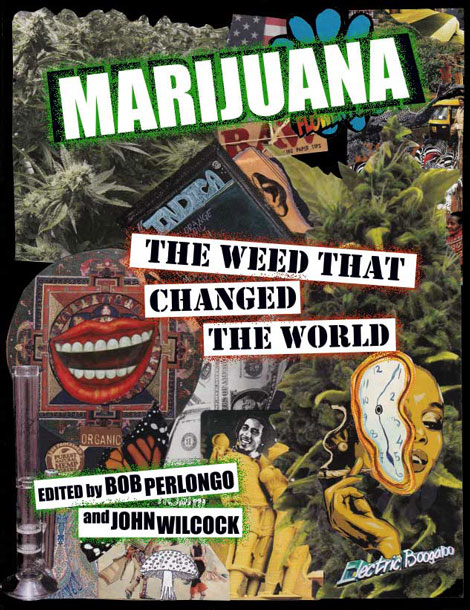
The Column of Lasting Insignificance: September 27, 2014
by John Wilcock
“I can only note that the past is beautiful because one never realises an emotion at the time. It expands later, and thus we don’t have complete emotions about the present, only about the past.”
— Virginia Woolf
“During the 1960s, I think, people forgot what emotions were supposed to be. And I don’t think they’ve ever remembered.”
— Andy Warhol

Chapter 11.
Andy Warhol (part 1)
First encounter….People talk about him….
His movies….We go to Rutgers, Ann Arbor …What people say about Andy
The first day I went up to the 47th Street Factory, as Andy Warhol tagged all his studios, the floor was covered with rows of silk screened paintings which his assistant Gerard Malanga was signing “A. Warhol” with a black-tipped brush. Our earlier encounter was when his then-cameraman Buddy Wirtschafter invited me to accompany him as they filmed one day at Willard Maas’ place in Brooklyn Heights. Buddy, who had enthused that Andy was “one of the greatest exponents of the art of the idea” suggested nonchalantly, “You can always hold the microphone or something”. As it happened, all I did on that occasion was watch with amused amazement. Andy himself was an impelling presence–I thought it was like being near a dangerous black hole–and I kept as low a profile as possible and spoke only when spoken to.
|
|
For some weeks I had been intrigued by this enigmatic artist, ever since at Jonas Mekas’ urging I had attended—against my better judgment–a screening of one of his early movies at Cinemateque. The uproar at that performance had made me realize that even incomprehensible films with bad sound could be impelling.
I had actually seen Andy before–at one of those flashy art scene openings featuring all kinds of pop artifacts such as silvery ‘chocolates’ made of lead. These were being handed out in a Warhol-themed bag by a pretty girl (Sarah Dalton) in a Brillo-patterned dress. There was a tremendous air of excitement around him, which intrigued me and prompted my continuing interest. “What Andy is selling, unlike traditional painters”, somebody remarked, “is not art so much as a milieu”.
Anyway, following this introduction by Buddy to the inner circle, I spent the next few months hanging out at the 47th Street Factory and accompanying them on their various outings.
I soon learned that Andy had gotten a taste for filming on that famous trip West, more talkative undoubtedly than he was on public occasions, “as we drove through the West Virginia night in my old Ford Station Wagon”, recalls Wynn Chamberlain, “ with Gerard and Taylor Mead sleeping in the back with all of Andy’s Elvis and Liz paintings, (we were) heading for LA and his show at the Ferus Gallery (Which was a terrible flop). There was a concurrent rumor that after Elizabeth Taylor had declined to sit for her portrait that Andy had dragooned Ruth Kligman into service as his model for the work. Elizabeth herself, who, being very smart and very kind, would certainly not (be likely to) interfere with people making millions on her visage…’the new Mona Lisa I suppose’” was the comment of one observer who claimed to know the truth of the matter.
Taylor Mead had been hanging around the Village for ages, feeding cats late at night on Lower East Side parking lots, before Andy came into his orbit, subsequently starring him in Tarzan and Jane Regained, Sort of. He was a veteran of a couple of avant garde films by Ron Rice, The Flower Thief and before that, Queen of Sheba Meets the Atom Man. In this 1963 epic he had spread butter on a football and then played the piano while wearing a bear suit. A stage role in a Frank O’Hara movie had earned him an Obie. (By the time of his 80th birthday in 2005, he’d appeared in scores of movies including Jim Jarmusch’s Coffee and Cigarettes. A widely-published poet, Taylor describes himself as a renaissance person. and performs weekly at a poetry club on the Bowery but is reticent about his acting career). “I don’t do anything”, he claims. “I just spontaneously happen into strange situations.”
What I hadn’t expected at the beginning was that filming at the factory would turn into an almost daily event, and that it would become so absorbing to watch somebody who obviously knew what he was doing even if it wasn’t the familiar way to do it. I found myself heading up to 47th Street every day and when, on occasion, the door was locked, rather than call up to be allowed in (I was never confident that this would happen) I went in via the fire escape. This was easier than it sounds because it was one of those typical New York fire escapes with a hinged lower part. All that was needed was the crook of an umbrella to reach above my head and pull it down.
At first, the camera would remain static during the filming, recording whatever action took place in the narrow spectrum before it. “(Andy) actually said to me once that his contribution was the unmoving camera because no one had done that”, confided Ronnie Tavel a poet hired as an assistant after Warhol attended one of his readings. “At that time I’m sure he didn’t think he would ever move the camera or edit, or he wouldn’t have made such a blunt statement. It was really like turning movies into paintings”.
Tavel was doing a little bit of everything but excelled as a script writer churning out the stark, realistic scenarios required. (Andy) wanted that modern thing, ‘I want it clean’, he said. ‘I want it simple, I want it plastic, and I want it white ‘. He always emphasized that, which for me was a new thing because I’m naturally prone to exoticism and fantasy and epic, which he detested. He couldn’t tolerate that at all. He really forced me to do (what he wanted) and some of my best stuff comes from doing that, you know, like doing the opposite of what you want is good exercise, and lo and behold, the king got good results, too.
|
|
“Well, I learned about directing, I learned about actors, about why certain people were photogenic and others were not, what registered dramatically. He knew (instinctively) about directing and where else could I have learned so quickly? He had this incredible showcase ’cause it was instant films; two weeks after I wrote the script it was showing in a movie house.
Andy has a magnificent belief in himself that he can create an audience, and he did. It took him a great many years of work on his part to do that: the publicity thing was really a fantastic effort to create an intellectual and artistic audience. I always had the feeling that the conceptual idea of what he did was so much more important than the actual thing. You could say that about Goya and Rembrandt –it’s the concept that is their genius and not the actual product”.
I asked Ronnie why Warhol was misunderstood by so many people who kept insisting that he was putting them on.
“Andy has the stigma of not being serious, but you create for yourself, you don’t create for a public. Life is very short, who goes about putting on themselves? And that’s all there is to say. And at this point I think it’s shocking to have him accused of being a put-on…he’s one of the major artists of our time”.
After several scripts, including The Chelsea Girls, Tavel was getting frustrated. He wanted to get more complex, to rehearse before shooting. “I felt we had outgrown our use for each other. I thought that he didn’t need scripts any more and he could do his best work without them, that they were holding him back. I don’t think writing should be part of that medium because words mean something and the script should not mean anything, the meaning should come from the film”.
Long before this time, I was having problems of my own–but for entirely the opposite reason. I was fascinated by the ambiguity of the Warhol scene and the sheer fascination of hanging around. I loved the way that every time I went up there would be something going on, some inexplicable drama that seemed unfathomable, a photo shoot by some German magazine, a letter from the Rolling Stones asking Andy to design an album cover or some avant garde movie director like Henry Jaglom basking in the ambiance. I later attended one of Henry’s screenings and it was met with such cries of outrage that next time he came over to the Factory I told him he must be a genius.
Among Andy’s occasional visitors was Arnold Schwartzenegger who, in the early sixties was a young hunk about town who subsequently made his mark with a body building demonstration at—of all places—the Whitney Museum. He was officially “discovered” by Jamie Wyeth, son of painter Andrew Wyeth, who introduced him to Andy who photographed him in detail. “I would imagine that those negatives are in the Warhol Museum in Pittsburgh”, my anonymous informant told me. “I liked Arnie: deeply kinky, yet compassionate; I liked him then and I like him now. He’s probably the only Republican left with any juice, which I suspect he picks up by being married to Maria Schreiber”.
There were always surprises at the Factory. During one of the frequent parties, I casually glanced at a television monitor that seemed to be displaying the scene but something seemed a little off-kilter. I quickly realized that what was appearing was the party of a few minutes before, the whole thing on a tape-delay which was totally new to me. Most of us, but especially me, were naïve about the new technology in those days and a similar gotcha! moment occurred the night we went to meet the Velvet Underground.
“We were taken to this grungry bar—sawdust on the floor—on West Third Street by Barbara Ruben, a young filmmaker whose recent movie had been composed of hundreds of single frames linked together to create the fastest montage it was possible to imagine. (Most movies unspool at 24 frames per second, at least three of which are usually devoted to each image giving it time to register). We sat in the front row at the Bizarre, a few feet from the horrendous noise of the musicians which sounded to my ears like a hurricane. (Lou Reed later chided me that I’d read a newspaper all during the gig). What I found most astonishing about the performance, however, was that when the musicians left the stage, the sound was still playing. Thus, my first acquaintance with the concept of ‘feedback’.
+++++++++++++++++++++++
Two Things Warhol Taught Me
To seize the moment and turn every
event into an opportunity
To listen to every idea without
bias and act upon the best.
+++++++++++++++++++++++
ANDY HIMSELF WAS ever an enigma, always friendly but never volunteering anything. He seemed at first intimidating to be around but I quickly learned that although he loves to have everybody telling him things he was unwilling, or perhaps unable, to answer direct questions. He’d hmn and hah and somehow end up saying nothing at all. So prudence dictated that one didn’t ask questions but tried to figure out what was going on. Understandably, this prompted endless conversations away from the factory. Why, for example did he wear a wig? “When you’ve got grey hair” he’d once said , “every move you make seems ‘young’ and ‘spry’ instead of just being normally active. It’s like you’re getting a new talent. So I dyed my hair grey when I was about twenty three or twenty four”. Okay, but why the wig? I never dared to ask.
Buddy had given me some pointers about how to behave: “Andy never explains to you what he is about and he surrounds himself with people who don’t need to be told what he is about, or understand it without direct communication. If you ask Andy a question, such as ‘what is it you want?’, which I have on many occasions, you’ll get an answer something like, “Well, what do you think?'”
But although I had learned the other essential rule–to be part of the coterie, you had to produce (although providing information was an acceptable substitute)–I was not in actuality doing anything.
Matters came to a head the day that Gerard offhandedly asked, “Andy was wondering when you were going to be writing something about us?” There was an undertone of mild threat which I interpreted as A reporter is part of our gang on sufferance. If he’s not actually providing any publicity for us, why is he around? Terrified of being dismissed, I rushed to the Voice that same day to compose, at white heat, a piece that described what I thought had been happening. Warhol, I wrote, was learning–but really teaching–something new about film-making.
“If Warhol has any specific point of view about his films,” I wrote in the Village Voice of May 6, 1965, “It is probably that what happens happens. He’s having a ball learning how to make movies and it’s merely gravy to him that if the movies become valuable art works because he happens to have made them…meanwhile the movies–screened once–pile up in silver cans in his silvered studio.
“The filming is fun. Like most amateur movie-making it casts that extraordinary spell that makes the onlookers believe they can go in and out of the action at will. For Horse, Warhol took a horse up in the elevator to his fourth-floor studio, stationing it near the door eating a pile of hay, enacting a parody Western in front of it complete with hokey hamming, drawled insults between the Cisco Kid and the sheriff, fist fights, a game of strip poker and facial mugging to an opera sound track. The horse, a stolid, black background, munches unconcernedly through the filming. The authentic Warhol touch comes from the characters peering through the lights to read their lines from scrawled shirt cardboards held up off camera”.
Mysteriously, all this took place so near the entrance that anybody coming up in the elevator was obliged to walk through the set after stepping out of the door, thus making an unscheduled appearance on film as did anybody who went over to use, or answer, the telephone. It was this kind of thing that prompted endless speculation among those of us not in the know (if, indeed, anybody was): were such interruptions planned or accidental?

Some THINGS WERE easier to fathom as, for example, when Andy would turn the camera off during shooting, producing a similar effect to turning off an old television set and watching the picture whirlpool into a white bubble at the center of the screen. Every professional filmmaker would have edited this out but Andy didn’t, thereby producing an oddly distinctive kind of punctuation between segments.
The strangest thing was that he almost never seemed to be doing anything other than standing there watching other people produce. Yet he had this incredible capacity to make people produce, although of course when you’re standing script-less in front of a camera that grinds inexorably away, it emanates a pressure all of its own to say or do something. But it always seemed that Andy was the eye of the storm, the calm centre around which everything else raged and roared while he retained absolutely equanimity.
I remembered the time I had stood with him in the gallery of the Dom, the decrepit former Polish dancehall on St. Marks Place to whose circling ‘glitter ball’ in the ceiling Andy had added films projected on all the walls simultaneously, yards of neon tape, a leather-clad, torch-waving Gerard dancing to the wailing of The Velvet Underground. It was a prototype of the early discotheque and both Andy and Paul were enthusiastic about the prospects the first time we all inspected the hall.
As we strolled across the gallery on the opening night of the Exploding Plastic Inevitable and looked down on the frenzied scene, somebody operating one of the spotlights said he needed to leave his post for a few moments. Without a pause Andy grabbed the nearest person and commanded him to take over.
The new recruit grabbed the spotlight apprehensively and shone it decorously upon Gerard and the Velvets. But almost immediately the neophyte discovered the color gels, and then the strobe light, and within seconds was blasting away in all directions, with all colors, with all speeds and with an intensity that made him appear to have done it all his life. Creativity, as Ronnie Tavel had said, can often be forced.
Every few days there would be a field trip. The entire entourage would pile into a limousine to go on location, usually at some elegant apartment whose owner had unwittingly responded to a request by Paul Morrissey to allow the Warhol crew—along with masses of equipment—to film.
Each adventure would begin with an encounter at the door at which Paul would politely introduce Andy and remind the would-be host of an earlier promise to allow her premises for filming. Then, almost before introductions were over, Paul would have sidled past the still-smiling host, checked out her apartment and returned in time to be ushered in with the rest of the group. It was an impressive performance. The welcoming smile on our host’s face, however, would long have faded by the time the crew left hours later, furniture rearranged, pictures knocked from the walls, the hardwood floors scuffed by cables, the refrigerator denuded of anything to drink and the bathroom closet cleaned of every conceivable pill as though a plague of locusts had passed through.
More than any time before or since I found myself defending the Warhol scene from people who knew nothing about Andy except what they’d read in the papers. One day as I was talking to the actress Viva, I asked her why so many people put down the factory crowd for being–what they erroneously assumed–was sexually licentious.
Her answer surprised me. “It’s because most people are all so guilty that their country is committing genocide” Viva explained. “They can’t face the fact that they’re all like Nazi Germany. They’ve got to work off their guilt on something else so they try to find something wrong with the morals of the country. So they can feel they should be complaining about something, when they should be complaining about the war”.
It was an interesting point because it had already occurred to a lot of people that everything that was going wrong with America was centrally linked yet the advocates of “bombing the gooks out of existence in Vietnam” were continually trying to say they were unconnected, the best example being when Martin Luther King had tried to fuse the plight of the black working class with the anti-war movement or when Leary’s acidheads found common ground with Dick Gregory’s battles against racism. Interestingly enough, the Left –or the Movement as it was rapidly becoming–was itself polarized, as I subsequently discovered was always the case.
Quotes about Warhol
“The interesting thing about Andy is that he didn’t approach films like a filmmaker, he approached films as an artist and consequently he used films to extend his art…he preceded the idea of minimal art in another movement, in other words minimal camera movement…”–Buddy Wirtschafter
“(He sometimes has) a very powerful anger. It’s incredible. Uptight for days. It’s an anger that is completely passive. He doesn’t say anything. He’ll mention your name and say, ‘oh so-and-so’, and that’s it. Completely uptight”.—Gerard Malanga
“Almost everything Andy does is of a comic nature. He refuses to be serious. But being comical is one of the most serious things. It requires an enormous amount of purpose and determination; to avoid being serious is very hard to do. Andy’s always avoided taking any serious position or taking himself seriously. Remember when he posed for the cover of Esquire falling into a soup can? Anything that seems silly or frivolous he goes along with. Anything that’s serious he avoids like the plague.—Paul Morrissey
“The last time I was up (at the Factory) Hedy Lamarr was there trying to get Andy interested in a health food store and he just sort of sneaked out. She looked around and couldn’t find him”–Taylor Mead
“I just came back from a Hollywood studio and they had to shoot through glass and they said, ‘my god we can’t do it, we’re going to get a triple reflection, blah, blah, blah.’ So they took the glass out, total nonsense, if Andy had been there he would have just shot right through it, and maybe would have got two or three, maybe five reflections, and it would have been beautiful–which someone in Hollywood would never have thought about…”—Ultra Violet
To my mind nobody except us was doing anything that approximates the real thing, a specific thing that’s very, very real, that wasn’t slick or a lie, which was the only way we could work with him. Because the first thing I liked about him was that he was very real”—Lou Reed
“He had this live and let live philosophy. He believed you shouldn’t alter the way things really are. That you can’t interfere with things, they have to happen just the way things happen, even if it happens to himself”—Gretchen Berg
“I wonder what goes on in his mind. If you’ve ever seen him at a party where he will just sit in a sofa for like four hours and people will come up and say, ‘Hi Andy, I haven’t seen you for three years’ and he’ll say, ‘Oh yes, you’ve curled or cut your hair’. Maybe he makes twelve statements during four hours. What is he doing? Where is his mind at?”—Sam Green
“(What has he contributed to) the art world? Well, in a general way I would say his freedom, his incredible sensitivity to what goes on in our present society, and his very superior, extremely valid aesthetic expression of these (because) usually painters of such logical themes are bad painters. In his case, along with Rauschenberg, he has achieved a sociological approach that doesn’t disturb the aesthetic value”—Leo Castelli
“I guess it was around ’66 when there was a blackboard in the studio on which I wrote with a piece of chalk ‘Andy Warhol can’t paint anymore and he can’t make movies yet, and that was like when he was between the two. He’s never forgotten that”—Henry Geldzahler
(From The Autobiography & Sex Life
of Andy Warhol by John Wilcock, 1971)
Bakewell (part 2), its mayor, and its pudding…
National Weed (1974, issue #3)
it’s here…



